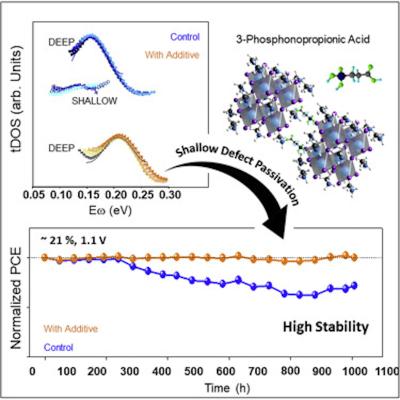An international team of scientists from ICN2, EPFL, Eindhoven University of Technology, University of Cambridge, Max-Planck Institute for polymer Research and several other institutions have fabricated perovskite solar cells which retained almost all of their initial 21% efficiency after 1,000 hours under continuous operation at their maximum power point.
The researchers attribute this performance to an additive that ‘blocked’ ions that cause device degradation, 3-phosphono propionic acid (H3pp), which served to greatly improve device stability with no observable effects on its solar performance. The team hopes this new work will contribute to an improved understanding of the relationship between efficiency and stability in perovskite PV.
Further analysis of the cells showed that the additive served to passivate ‘shallow’ defects in the material – creating strong hydrogen bonds that essentially block ion migration that can cause degradation in the material. Deeper defects that assist in cell performance, meanwhile, were left untouched.
“The H3pp additive strongly bonds to the perovskite… via two types of hydrogen bonds (H.IandO.H), passivating shallow point defects,†the researchers explain. “Given that the passivation does not occur through deep defects, the non-radiative recombination is not mitigated, and the device performance (Voc and efficiency) remains unaffected by the presence of the H3pp additive.â€
Beyond demonstrating this impressive device performance, the group hopes its research will help to improve understanding of different defect types that exist in a perovskite material, the characteristics they are responsible for, and ways to influence one without affecting another.
Halide perovskites are “soft†ionic electronic conductors with a strong ionic component, which now, thanks to the results of this work, can be associated to shallow point defects. “This research provides new relevant information about the impact of defects in halide perovskite solar cells that will certainly help disentangle the effects of distinct defects on the different properties of the devices,†the group concludes.


